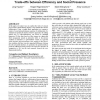Free Online Productivity Tools
i2Speak
i2Symbol
i2OCR
iTex2Img
iWeb2Print
iWeb2Shot
i2Type
iPdf2Split
iPdf2Merge
i2Bopomofo
i2Arabic
i2Style
i2Image
i2PDF
iLatex2Rtf
Sci2ools
CSCW
2006
ACM
2006
ACM
Spatiality in videoconferencing: trade-offs between efficiency and social presence
In this paper, we explore ways to combine the video of a remote person with a shared tabletop display to best emulate face-to-face collaboration. Using a simple photo application we compare a variety of social and performance measures of collaboration of a standard non-spatial 2D interface with two approaches for adding spatial cues to videoconferencing: one based on simulated immersive 3D, the other based on video streams in a physically fixed arrangement around an interactive table. A face-to-face condition is included as a `gold-standard' control. As expected, social presence and task measures were superior in the face-toface condition, but there were also important differences between the 2D and spatial interfaces. In particular, the spatial interfaces positively influenced social presence and copresence measures in comparison to 2D, but the task measures favored the twodimensional interface. Categories and Subject Descriptors H.5.3 [Information Systems]: Information Interfac...
| Added | 22 Aug 2010 |
| Updated | 22 Aug 2010 |
| Type | Conference |
| Year | 2006 |
| Where | CSCW |
| Authors | Jörg Hauber, Holger Regenbrecht, Mark Billinghurst, Andy Cockburn |
Comments (0)

